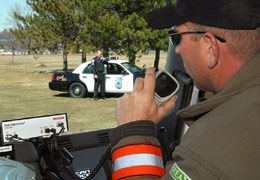By Jamie Thompson
FireRescue1 Editor
 Photo courtesy of BAE Systems |
Of the many challenges major incidents pose for firefighters, interoperability is certainly right near the top of the list. Effectively communicating and working with other agencies and departments can be paramount to the ultimate success of an operation.
A relatively new technology on the market is allowing radios operating on different frequencies and protocols to communicate with each other.
BAE Systems’ First InterComm™ technology enables cooperation between first responders by “bridging communications.”
“It means every agency can use different radios, different frequencies and different manufacturers and still be able to communicate,” said Mike Greene, Director of Homeland Security Solutions for BAE Systems.
The First InterComm system works by mounting a special unit inside a vehicle and using the responder’s existing radio frequency. It runs off the vehicle’s battery and requires no operator involvement and survives natural or manmade disasters because it does not depend on radio towers or base stations.
When another vehicle with a First InterComm unit installed arrives at the scene, the system automatically creates a “temporary mesh network” and enables communications among additional radio frequencies and even different types of radios. It is designed to be used every day and scales to the size of the incident as more agencies arrive at the scene.
“It means every agency can use their existing radios and be able to communicate instantly,” Greene said.
Earlier usage
The system is based on knowledge first developed by the global defense contractor in a program designed for military use.
“Using the knowledge we developed with that program and having spent time with first responders across the nation discussing their problems, we came up with a solution that meets their needs,” Greene said.
“The system is designed to be automatic and can automatically sense other vehicles arriving with First InterComm units.”
Existing options for creating interoperability between different agencies include developing a single radio system or the setting up of a common frequency and protocol.
Rolling out a new radio system can take several years while the second option, Greene said, can be challenging because the criteria for accessing such a frequency is high.
First InterComm, Greene said, creates a gateway system that interfaces between different radio systems and frequencies, making it a cost-effective and simple solution.
“We have approached the problem in a way different from anybody else so we can provide immediate interoperability,” he said. “Other solutions require special equipment to be deployed when someone decides that it’s important to do so. But our system is immediate, ready to be used every day.”
A basic unit measures 8.625" x 8.625" x 2.5", small enough to be mounted in any vehicle and costs about $5,000.
Each responding agency that has a First InterComm unit installed configures it to their own communications device and frequency. When arriving at the scene, Greene said, responders switch their radios to the designated channel. Any radio messages they subsequently transmit are received by the First InterComm unit, which converts it and relays it across the mesh network to other units — and in turn, to other radios.
“We are not trying to replace all of their radios; that’s such a costly proposal,” Greene said. “Instead we’re allowing them to use their existing radio and linking those to everybody else’s.”











